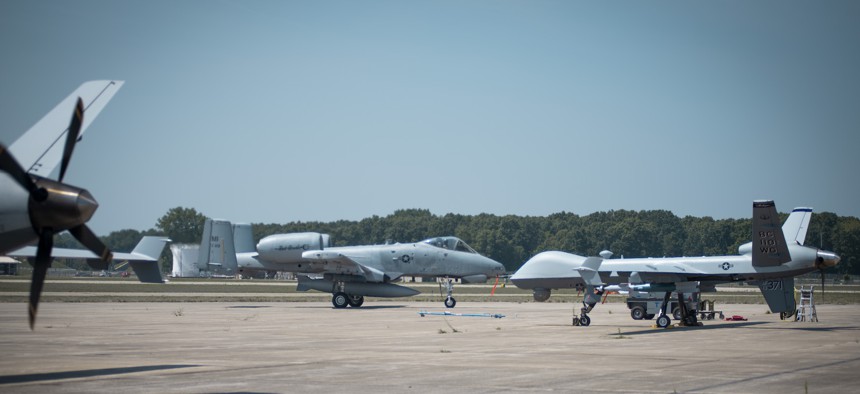
Dual remote-piloted MQ-9 Reapers and dual A-10 Thunderbolts at Battle Creek Air National Guard Base, Michigan, on Aug. 4. U.S. Air National Guard / Bethany Rizor
Air Force bristles at congressional cost limits for robot wingmen
But one lawmaker says the drone program needs safeguards against the Pentagon’s costly acquisition process.
A congressional effort to impose cost-control guardrails on the Air Force’s program to build drones that will fly alongside manned fighters is drawing fire from the service.
The proposal from the House Armed Services Committee would force the Air Force to divvy up drones in its robot-wingman program, known as “collaborative combat aircraft,” into specific categories whose cost limits would range from $3 million to $25 million.
“We're very opposed to those cost targets. I don't know where those categories came from. They're not what we're doing,” Air Force Secretary Frank Kendall told reporters Sept. 11 at the Air & Space Forces Association’s annual conference.
The Air Force and Navy secretaries would be required to categorize drones by category: “expendable,” “attritable,” and “exquisite”—if the provision in the HASC’s version of the fiscal 2024 National Defense Authorization Act makes it into the final bill.
The provision was drafted because the Pentagon has started programs that were intended to be affordable “but often ended up procuring fewer items than anticipated due to expanding capability requirements and acquisition process complexities,” said Rep. Rob Wittman, R-Va., chairman of the HASC’s tactical air and land forces subcommittee.
Under the legislation, the cost of an expendable CCA, which lawmakers define as a drone that’s designed to be lost after its mission, would be capped at $3 million. An attritable CCA, which is meant to fly multiple missions and “may not return,” would be capped at $10 million. Lastly, an exquisite CCA, which is designed for multiple missions and “not considered an acceptable loss,” would be capped at $25 million.
These cost limits were proposed so the Pentagon could actually buy drones in mass, Wittman told Defense One. “Safeguards” on this program are needed to realize the “full potential” of manned-unmanned teaming, he said.
The three categories were also initially the Air Force’s idea, the congressman said. While the service no longer wants to pursue that approach, Wittman said his subcommittee thought it was a “logical strategy” and established the cost targets “based on discussions with the USAF and independently assessed the current figures as a foundation for future conversations with both the Air Force and Navy.”
The Air Force is looking at the program with “two increments” in mind, instead of the three categories Congress has proposed. “Increment one” aims to field drones quickly and achieve affordable mass, while “increment two” will expand CCA capabilities and incorporate lessons learned from the service’s operational experimentation unit, said Brig. Gen. Dale White, program executive officer for fighters and advanced aircraft.
Once the drones are in the hands of airmen, “they're going to find new and innovative ways to determine how this capability changes that fight, and so I think that's going to feed into the discussion and the learning process that will really form up what we think increment two looks like,” White told reporters Sept. 13 at the AFA conference.
White wouldn’t disclose the cost targets the Air Force is shooting for, but stressed the importance of keeping CCAs affordable. The service has built the CCA program with affordability in its “foundation,” he said.
“At the end of the day, I think the most important thing we have said from day one: This is about affordable mass. You're not going to achieve the mass in any form if it's unaffordable, and we keep that in mind in how we execute this program,” White said.
The Senate’s version of the bill does not set the same limits on CCA development, but includes language that requires the Air Force secretary to provide additional information on the acquisition of the drones. Lawmakers have not yet resolved differences between the House and Senate versions of the NDAA.




